CoinWeek Ancient Coin Series by Mike Markowitz …..
“Why put a date on a coin?” Most suggest that the mint used a date to monitor quality control, manage the workmanship, or protect its product from counterfeiting. In truth, mints starting placing dates on coins because they could (Cohen, 7).
DATES[1] ARE SO universal on modern coins that it may come as a shock to learn that most ancient coins provide no indication of when they were minted. The “Common Era” (or “AD”, Anno Domini) dating system used in our world to designate years did not come into general use on European coins until the 16th century[2]. A wide variety of dating systems were used by different cultures in the ancient world to keep track of years, and in some cases, these appear on coins.
Zankle
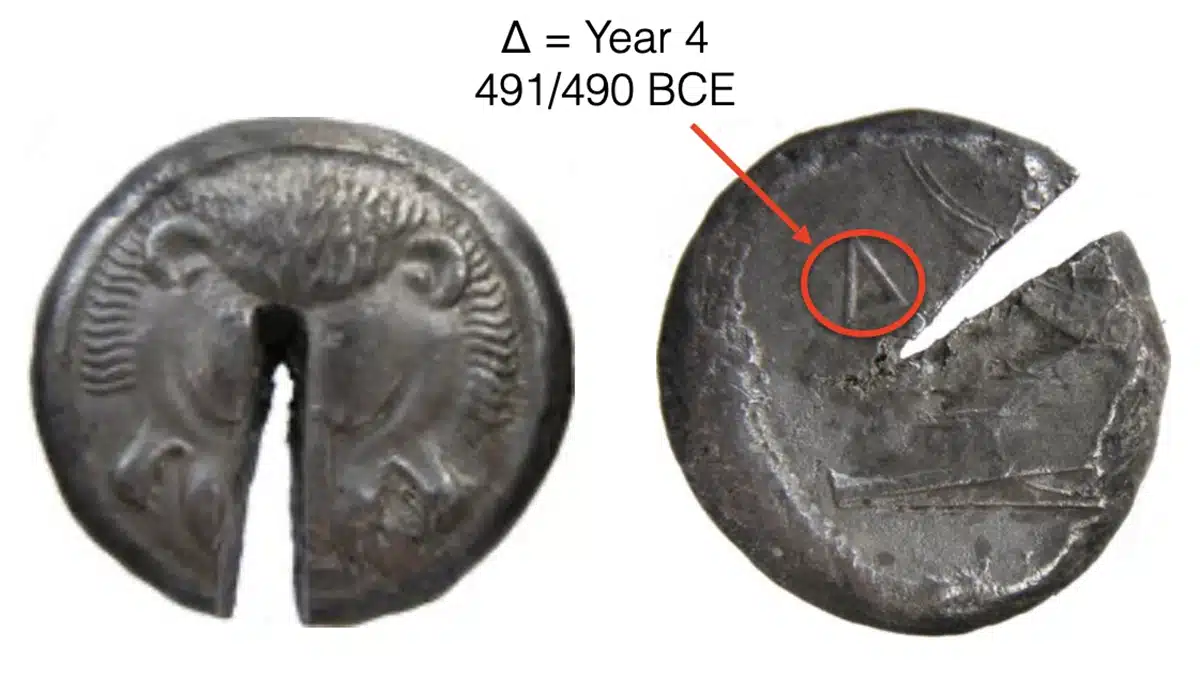
The earliest coins to bear a year date were a brief experiment – lasting just six years – by Greek refugees from the Aegean island of Samos who fled the Persian occupation of their homeland to settle at Zankle (today Messina, Sicily) in 494 BCE. On coins they struck, they dated their arrival as “Year One”, indicated by a prominent letter A (alpha, the Greek numeral for 1). Coins are known for Years 1, 2, 4, 5 and 6, but no coin of Year 3 has ever turned up. These silver tetradrachms show the head of a lion on the obverse, and the prow of a ship on the reverse. One of the few published examples of this series that I found is dated Year Four (with delta, Δ, the fourth letter of the Greek alphabet) in the collection of the American Numismatic Society (ANS) in New York[3]. The coin, from the famous Asyut Hoard found in Egypt in 1969, has a deep chisel cut that nearly broke it in half.
Samos
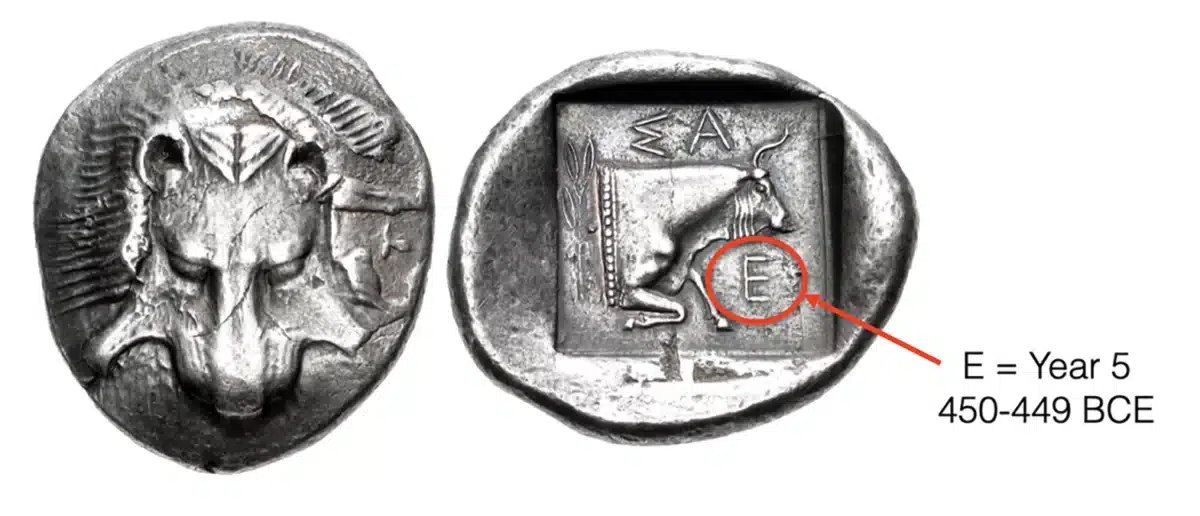
Back on Samos a few decades later, this experiment was repeated. From 454 to 440 BCE, silver tetradrachms of Samos were dated with a sequence of Greek alphabetic numerals. The date letter appears on the reverse, below the chin of a bull. A rare example with a date from Year 5 brought $8,000 USD in a 2021 U.S. auction[4]. The experiment was abandoned in 439 when Samos was defeated in a short war by Athens[5].
Arsinoe

Arsinoë II was the daughter of Ptolemy I, a Macedonian general who became the first ruler of Egypt’s Ptolemaic dynasty. Born in 316 BCE, Arsinoë died some time between 270 and 268. But before that happened, she became Queen of Egypt upon her marriage to her brother Ptolemy II in 273 (confusingly his first wife, Arsinoë I, a Macedonian princess, had the same name).
Coinage in the name of Arsinoë II is all posthumous; after her death she was deified (declared a goddess) by her brother-husband. Her name appears as ΑΡΣIΝΟΗΣ – ΦΙΛΑΔΕΛΦΟΥ (Arsinoes Philadelphou, “Brother-loving Arsinoe”). A massive gold octodrachm or mnaion (27.8 grams) from the mint of Ake-Ptolemais (today Akko, Israel) is dated to Year 35 of Ptolemy II, which corresponds to 251/250 BCE[6].
Cleopatra
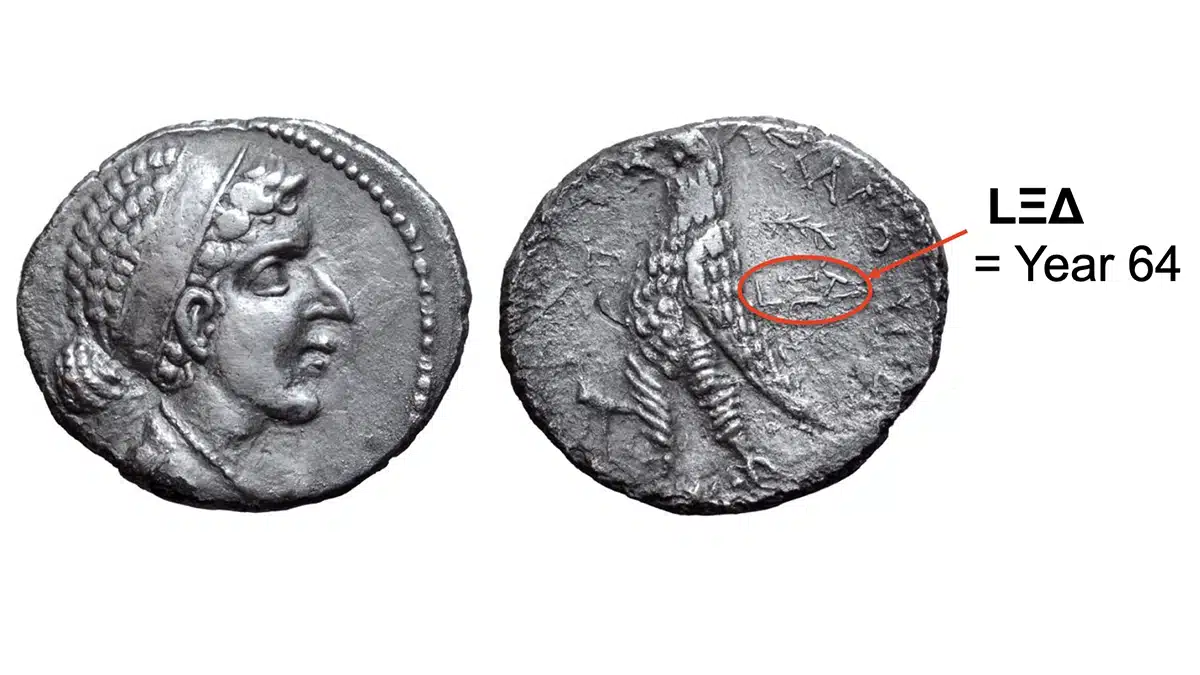
One of the most famous women of ancient history, Cleopatra VII of Egypt issued coins that are avidly sought by collectors. There are many bronze coins bearing Cleopatra’s portrait. But the only Ptolemaic silver coin on which she placed her own portrait is a very rare tetradrachm from the mint of Ascalon (or Ashkelon) on the coast of Palestine[7]. The date appears on the reverse as LΞΔ, meaning “Year 64”. “L” in this case is not a numeral; it’s not a Greek letter at all, but a kind of scribal abbreviation or shorthand for “year”. The date is based on the local era of Ascalon, which gained independence from the Seleucid Empire in 104/103 BCE, so Year 64 corresponds to 41/40 BCE, the 10th year of Cleopatra’s reign. On Harlan J. Berk’s list of the 100 Greatest Ancient Coins, this type is #30 (Berk, 82). Only about five examples of are known.
Tyre Shekel

The Phoenician city of Tyre (today Sur, Lebanon) was a major commercial power in the international trade of the ancient Mediterranean. Silver shekels and half-shekels of Tyre enjoyed a good reputation for the purity of their metal. Although they bore the graven image of the Tyrian city god, Melkart (identified as Herakles by Greeks and Romans), these were the only coins acceptable for payment of the annual Jewish temple tax in Jerusalem. These coins were dated in Greek numerals according to the local era of Tyre, which began in 127/127 BCE.
Among collectors of Biblical-related coins, the most desirable date is considered to be 33/34 CE, which many sources consider to be the year of the Crucifixion of Jesus. It is thought that these coins were the “thirty pieces of silver” paid to Judas Iscariot[8]. The date 33/34CE corresponds to Year 159 in the Tyrian civic era, written as rho-nu-theta (PNΘ) in Greek numerals[9]. On Harlan Berk’s list of the 100 Greatest Ancient Coins, this type is #62 (Berk, 94).
Pontius Pilate
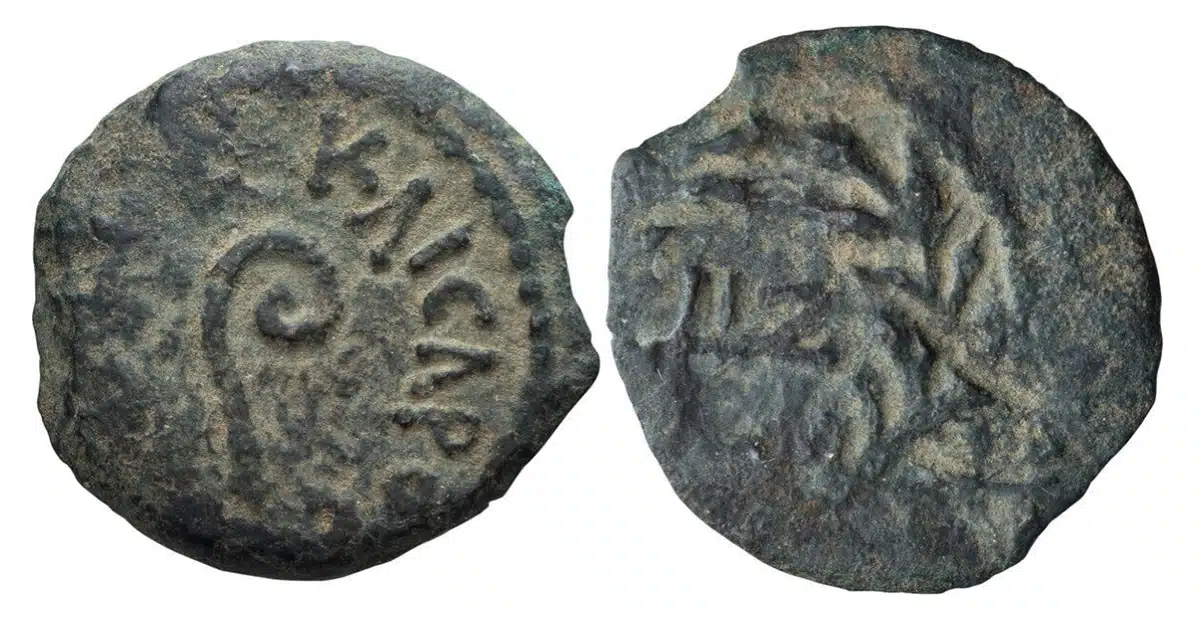
A series of Roman “procurators” governed Judaea in the first century. Small change in bronze was issued at Jerusalem by these procurators from time to time to meet local needs. Inscribed in Greek, these coins bear the name and sometimes the regnal year of the current emperor. The most famous of these was Pontius Pilatus (“Pilate” in the Gospels), under whose administration Jesus was crucified. Pilate served from 26 to 36 CE. The coins are not rare, with some 780 examples listed on CoinArchives Pro in November 2023. Pilate only issued coins in Years 16, 17, and 18 of Tiberius (corresponding to 29/30, 30/31 and 31/32 CE). Usually poorly struck and badly centered, these are some of the most popular Biblical-related coins. One type bears a lituus, a spiral wand used by certain Roman priests[10]. This pagan symbol would have been offensive to the Jewish population.
Hadrian
The usual way that Romans dated events was by reference to who were the consuls for that year[11]. Consuls were the chief executives of the Roman republic, elected annually. The sequence began in 509 BCE with the consulship of L. Junius Brutus (an ancestor of Caesar’s assassin) and L. Tarquinius Collatinus. For example, the year of Caesar’s birth, 100 BCE, was the “consulship of L. Valerius Flaccus and the sixth consulship of Gaius Marius.” But Roman coins were never dated by consulships.

A less common way of dating events was Ab Urbe Condita, “From the Founding of the City”, abbreviated AUC.This date is counted from the legendary founding of Rome on April 21, 753 BCE. A unique example of AUC dating in Roman numerals is found on a gold aureus of Emperor Hadrian. The coin commemorates Hadrian’s establishment of chariot races in the Circus Maximus[12], Rome’s huge stadium, on Rome’s birthday in 121 CE. The coin’s reverse shows a muscular reclining figure, the “spirit of the games”, with one arm wrapped around the stadium’s conical turning post, cradling a chariot wheel in his other arm. The Latin inscription is ANN DCCCLXXIIII NAT URB P CIR CON. The first part means “Year 874 from the birth of the city”; the meaning of P CIR CON is debated. Options include Populo Circenses Concessit (“Games in the Circus Given to the People”) and Primum Circenses Constituti (“Games in the Circus First Instituted”). On Harlan Berk’s list of the 100 Greatest Ancient Coins, this type is #66 (Berk, 103).
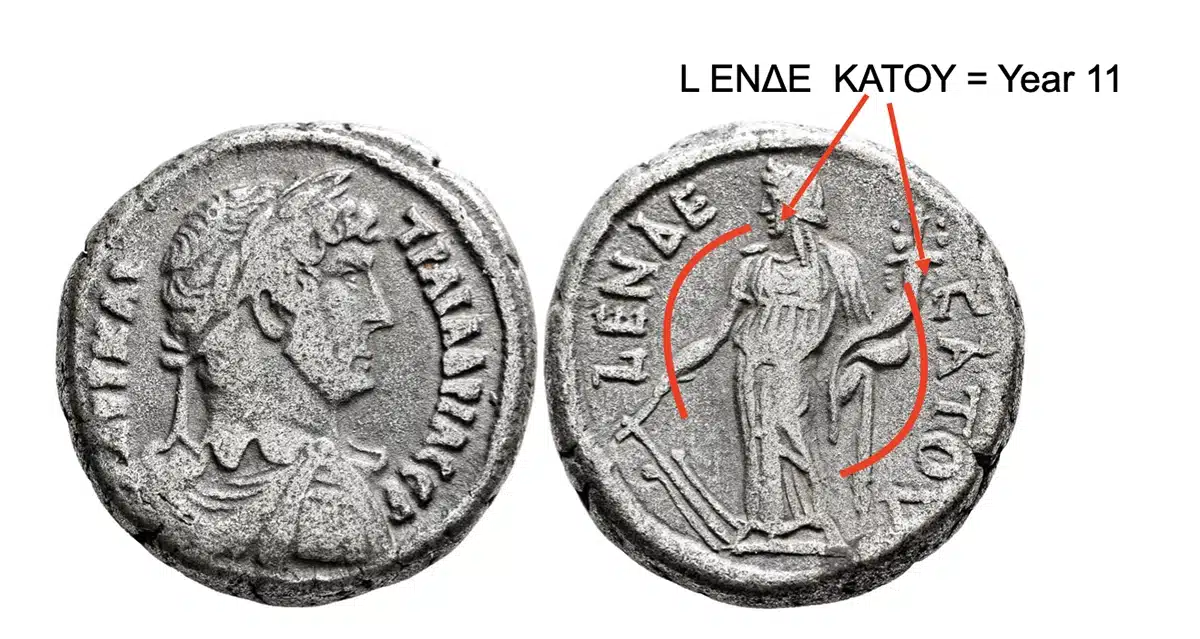
A series of coins issued in the name of Hadrian at Alexandria for circulation in Egypt are dated with the emperor’s regnal year as Greek words, spelled out in full. Greek was the administrative language of Roman Egypt and the native tongue of much of Alexandria’s population. A billon tetradrachm bearing the figure of Tyche, goddess of good fortune, is date to the 11th year of Hadrian (126/127 CE) with the inscription L ΕΝΔΕΚΑΤΟΥ[13] (endeka being the Greek word for “eleven”).
Pacatian
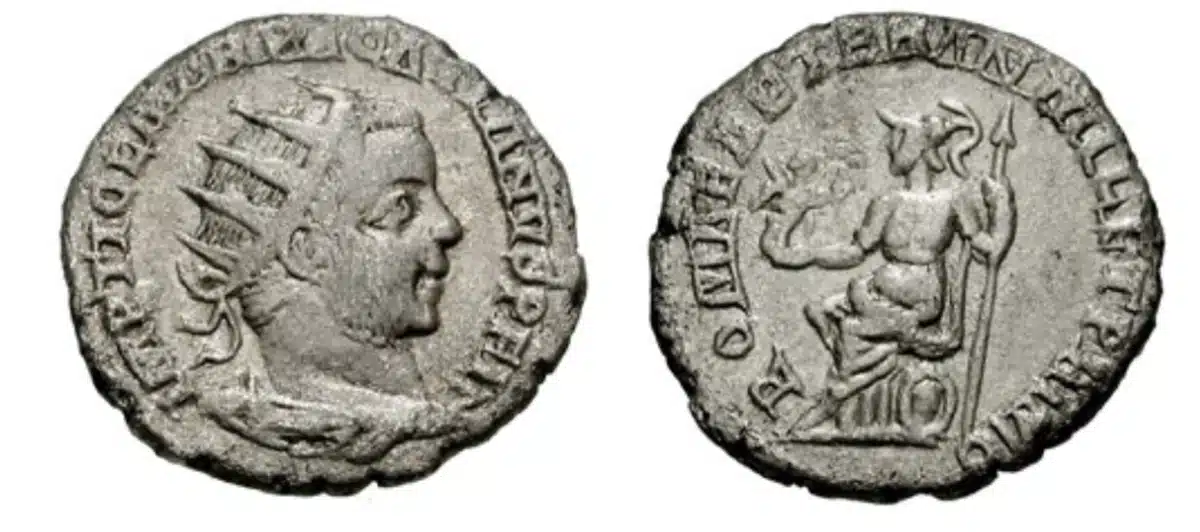
Very little is known about the life of Tiberius Claudius Pacatianus. He commanded one of the Danube legions during the chaotic third century CE and was proclaimed as emperor by his troops in the spring or early summer of 248. Emperor Philip I (“the Arab”, ruled 244-249) sent his general Trajan Decius to crush Pacatian’s revolt. After a few weeks, or possibly a few months, Pacatian was murdered by his own soldiers (a common fate of Roman usurpers during this period of “military anarchy”). Soon afterward, Decius’s troops proclaimed him emperor, and he defeated Philip, who was killed. Pacatian’s rare coins, possibly struck at Viminacium[14] in what is now Serbia, include one type[15] with a unique dating formula: ROMAE AETER[nae] MILL[esimo] ET PRIMO (“the Thousand and First Year of Eternal Rome”).
Justinian
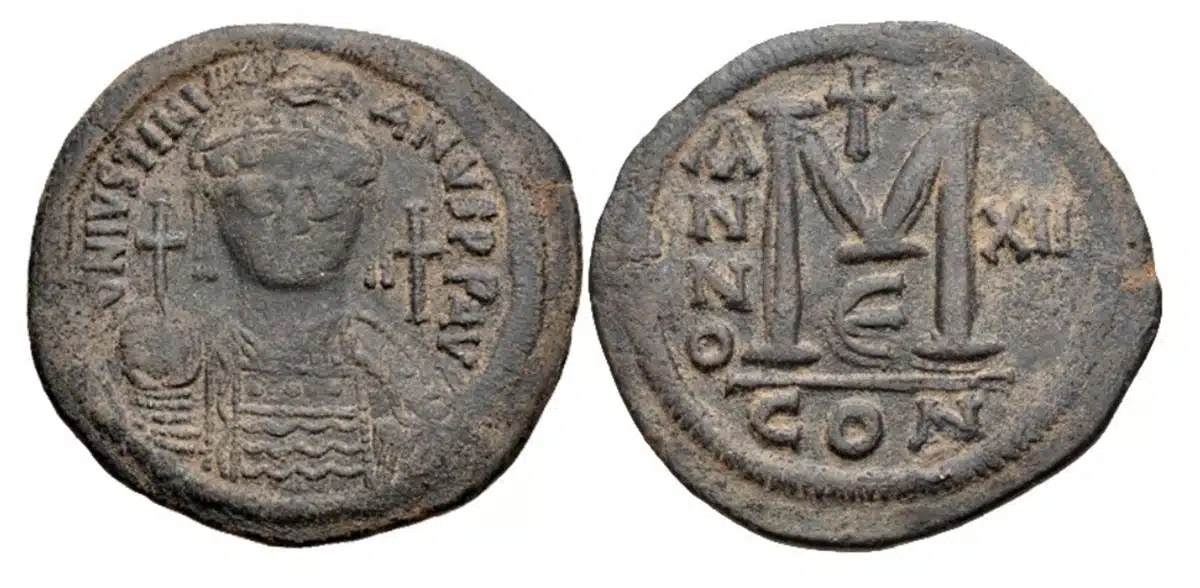 Electronic Auction 27916 May 2012 Lot: 645 realized: $65″ width=”1200″ height=”588″ />
Electronic Auction 27916 May 2012 Lot: 645 realized: $65″ width=”1200″ height=”588″ />Remembered as Justinian “the Great”, he ruled at Constantinople from 527 until his death in 565. In the Eastern Roman (“Byzantine”) Empire the year started on September 1st. Some gold coins were dated with Greek numerals according to the “Indiction”, a 15-year tax assessment cycle, but this was not used consistently. In 538, Justinian decreed that all official documents were to be dated according to emperor’s “regnal year” (often abbreviated as RY), which began when he came to the throne on August 1, 527. Justinian’s coins begin to carry these dates with Regnal Year 12, which corresponds to 538/539 CE. The reverse of Justinian’s bronze follis is inscribed with the Latin word ANNO (“in the year”) and the regnal year in Roman numerals[16]. On Harlan Berk’s list of the 100 greatest ancient coins, this type is #98 (Berk, 121).
Alfonso
 Triton X9 January 2007 Lot: 1165 realized: $3,000 ” width=”1200″ height=”675″ />
Triton X9 January 2007 Lot: 1165 realized: $3,000 ” width=”1200″ height=”675″ />Remembered as “Alfonso el Noble”, Alfonso VIII was king of the Spanish kingdom of Castile from 1158 until his death in 1214. He led a Christian coalition that shattered the Muslim Almohad Caliphate of Spain at the decisive battle of Las Navas de Tolosa[17] in 1212.
His wife Eleanor was a daughter of the English king Henry II. To commemorate his recapture of the strategic city of Toledo 1166, Alfonso issued the first European coins to bear a date since Roman times. The coin is a denier (1.08) struck in billon, a copper alloy with less than 50% silver[18]. The obverse bears a cross surrounded by the inscription ERA MCCIIII. This is the year 1204 in the local “Es-Safar” calendar, which was 38 years ahead of the Anno Domini (AD) system.
Valdemar II

20 November 2008. Lot 795/ 186. Estimate: DKK 250,000, approx $35,838. Unsold.
The first coin known to be dated according to the Anno Domini or “Common Era” was struck at Roskilde, capital of medieval Denmark, in the year 1234 CE. The coin was issued by Niels Stigsen, Bishop of Roskilde, during the reign of King Valdemar II “the Victorious” (ruled 1202-1241). The coin is a penning or “penny” struck in billon, weighing 1.00 gram. It bears a crown on the obverse with the inscription ANNO DOMINI (“Year of the Lord”) and a miter (bishop’s hat) on the reverse, with the inscription MCCXXXIIII (“1234”). Only seven examples of this coin are known, with six in museums. This example failed to find a buyer in a 2008 Danish auction, with an estimate of 250,000 Danish kroner (about $35,838[19]).
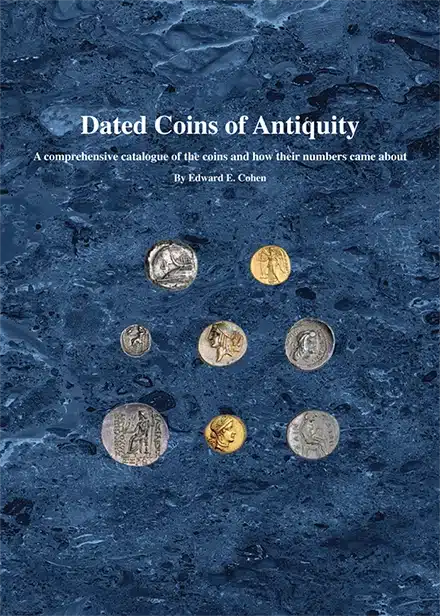
Collecting Dates on Ancient Coins
For collectors interested in dates on ancient coins, the essential reference is Cohen (2011); at 652 pages, a bargain for $135. The standard reference for medieval dated coins is Levinson (2007), at 336 pages which can be found for about $75.
* * *
Notes
[1] “Date” in this context means the numerical designation of a year, not the sweet fruit that grows on certain palm trees, or a social engagement with a prospective intimate partner.
[2] https://en.wikipedia.org/wiki/Common_Era
[3] http://numismatics.org/collection/2008.39.4
[4] CNG Auction 117, May 19, 2021, Lot 224. Realized $8,000 USD (estimate $3,000).
[5] https://en.wikipedia.org/wiki/Samian_War
[6] NAC Auctionn 66, October 17, 2012, Lot 79, realized CHF 130,000 (about $140,860 USD; estimate CHF 25,000).
[7] Roma Numismatics Auction XIII, March 23, 2017, Lot 428. Realized £70,000 (about $87,686 USD; estimate £50,000).
[8] Matthew, 26:15
[9] Goldberg Auction 135, June 18, 2023, Lot 1597. Realized $6,750 USD (estimate $7,500).
[10] Harlan Berk, Sale 223, June 22, 2023, Lot 370. Realized $250 USD (estimate $250).
[11] A complete list can be found at wikipedia.org/wiki/List_of_Roman_consuls
[12] https://en.wikipedia.org/wiki/Circus_Maximus
[13] Leu Web Auction 26, July 8, 2023, Lot 2847. Realized CHF 70 (about $79 USD; estimate CHF 50).
[14] https://en.wikipedia.org/wiki/Viminacium
[15] CNG Triton VII, Janaury 12, 2004, Lot 1018. Realized $13,000 (estimate $15,000)
[16] CNG E-auction 279, May 16, 2012, Lot 645. Realized $65 USD (estimate $100).
[17] https://en.wikipedia.org/wiki/Battle_of_Las_Navas_de_Tolosa
[18] CNG Triton X, January 9 2007, Lot 1165. Realized $3,000 USD (estimate $4,000).
[19] Bruun Rasmussen, November 20, 2008, Lot 795/186. Unsold (estimate DKK 250,000) $35,838.
References for Dates on Ancient Coins
Berk, Harlan J. 100 Greatest Ancient Coins. 2nd edition. Pelham, AL (2019)
Bickerman, E. J. Chronology of the Ancient World. 2nd edition. Ithaca, NY (1980)
Cohen, Edward. Dated Coins of Antiquity. Lancaster, PA (2011)
Cook, B. F. Reading the Past: Greek Inscriptions. Berkeley, CA (1987)
Friedberg, Arthur L. Coins in the Bible. Atlanta (2004)
Hartmann, John and George Macdonald. Greek Numismatic Epigraphy. Chicago (1969)
Hendin, David. Guide to Biblical Coins. 6th edition. New York (2021)
Kraay, Colin. Archaic and Classical Greek Coins. New York (1976)
Levinson, R.A. The Early Dated Coins of Europe 1234–1500. 2nd edition. Williston, VT (2019)
Sayles, Wayne G. Ancient Coin Collecting II: Numismatic Art of the Greek World. Iola, WI (1997)
* * *
The post How to Read Dates on Ancient Coins appeared first on CoinWeek: Rare Coin, Currency, and Bullion News for Collectors.